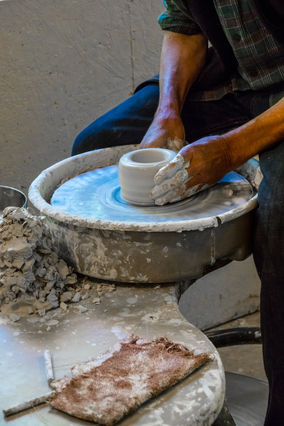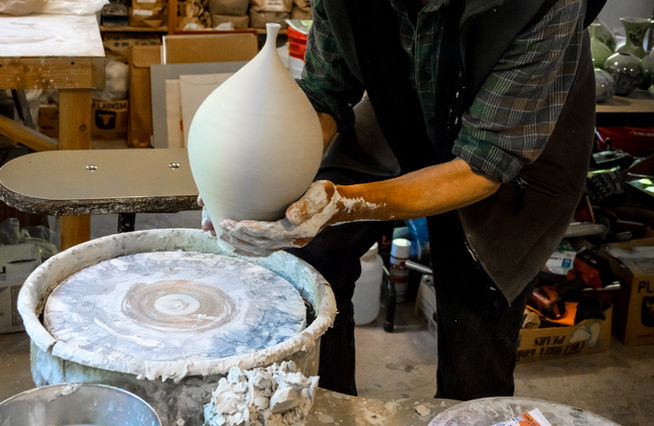About
Theory and Practice
Each piece of pottery is made entirely by me, on a kick-wheel, with a nod to traditional methods.
The shaping is finished in the wet state and the foot trimmed with a stick, before the pot is cut from the wheel-head. When the pot has begun to harden, the foot is refined as needed, but the body is never trimmed. This preserves the skin-like clay surface, and helps promote a more natural look and feel to the finished piece, whether or not it ends up being covered with glaze. Most pieces are thrown quite thinly and evenly, which is another reason I don’t trim, except for bowls.
The glazes are applied by dipping or pouring. I have never bothered with a spray gun.
The burnished pieces are polished by hand with a smooth stone. I never burnish on the wheel. As with trimming, it seems to take some life out of the piece, and gives the appearance of being turned on a lathe.
I like all my pieces to have a natural look, as if they had been formed without human intervention. Looking back at my fifty plus years of being involved with ceramics, my favorite pieces seem to contain the right amount of tension between sophistication, on one hand, and some kind of earthiness / folkiness / tradition on the other. The skilled and sophisticated aspects of a particular piece can help validate whatever risks are taken through whimsy and earthy imperfection, and these folkier aspects act to take the edge off what otherwise might become dull, ordinary perfection.
I’ve always been interested in the type of design elements found in nature. Now, the “crystal universe” is contributing its own style of artwork from some far corner of nature, to the surface of the crystal-glazed pieces. Check out the photos!
The Potter's Wheel
---- In Ancient Egyptian mythology, the deity Khnum was said to have formed the first humans on a potter's wheel.
I make all my pottery exclusively on a kick-wheel, as shown in the series of photos below. I bought this Robert Brent Wheel way back in the summer of 1974, and I must say it has served me well through the years. It's never needed a single replacement part, or even required a drop of oil. In fact, it’s the only wheel I’ve ever owned.
I appreciate the inherent simplicity of a kick-wheel, and the silent motion with its lack of vibration. As with a finely-tuned bicycle, it’s all about working with natural forces, rather than a motor.
Unlike the constant speed of an electric wheel, the speed of a kick-wheel constantly slows as one lifts the wall of a piece. This makes throwing a large pot more difficult, as I like to finish a lift before the wheel slows too much. In practice, this means that each lift must start with the wheel spinning at a pretty good clip, then slowing to a crawl as the lift nears the rim of the piece, all the while keeping the surface finger marks as even as possible. I believe the extra challenges involved with the use of a kick-wheel can teach the potter a lesson or two about improving their throwing skills.
The Crystal Universe
My particular crystal glazing process tends to produce zinc-silicate crystals in roundish shapes, floating on a contrasting field which can be both plain or textured. Ideally those crystals will float on a multi-textured surface, but crystal firing is notoriously difficult to control.
When I get lucky, a finished pot will show a few mysterious reddish-gold crystals or other unusual effects. Under magnification, these novel crystals and background designs exhibit amazing detail, as do the more typical zinc-silicate crystals.
When I notice an interesting looking area on the surface of a piece, I compose a photograph of the scene. I’m always impressed by how these crystal shapes seem to arrange themselves in only a few hours during the molten state to form these miniature artistic compositions. There are no photoshop effects in these scenes, only straight photos of self-assembled art.
All photos of Stephen in his studio by Andrea Fortunoff © 2019
















